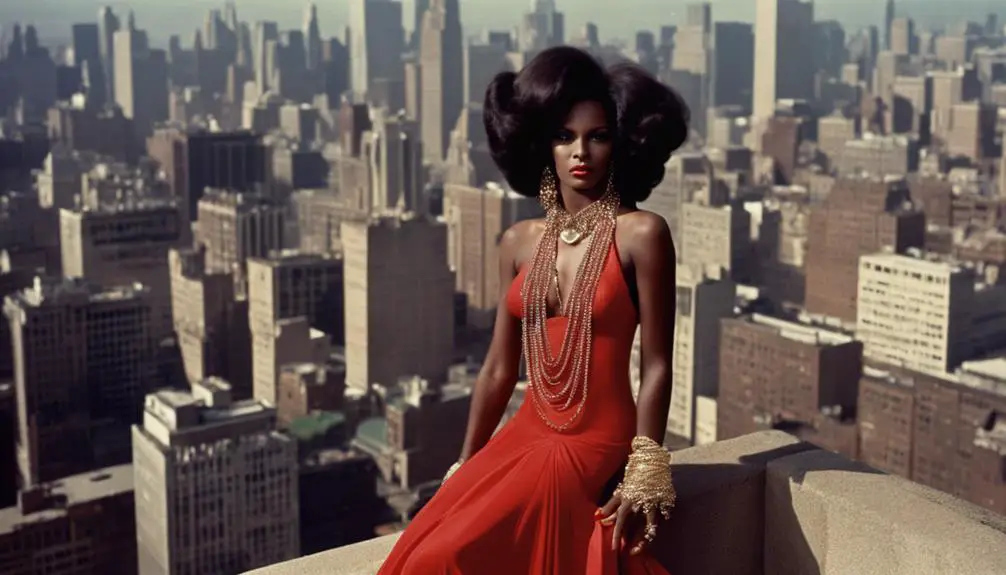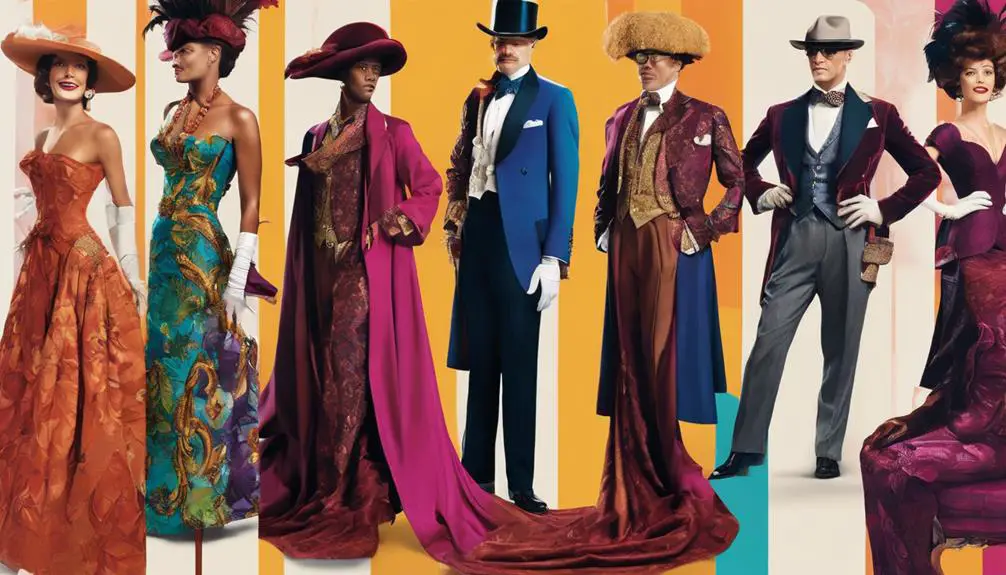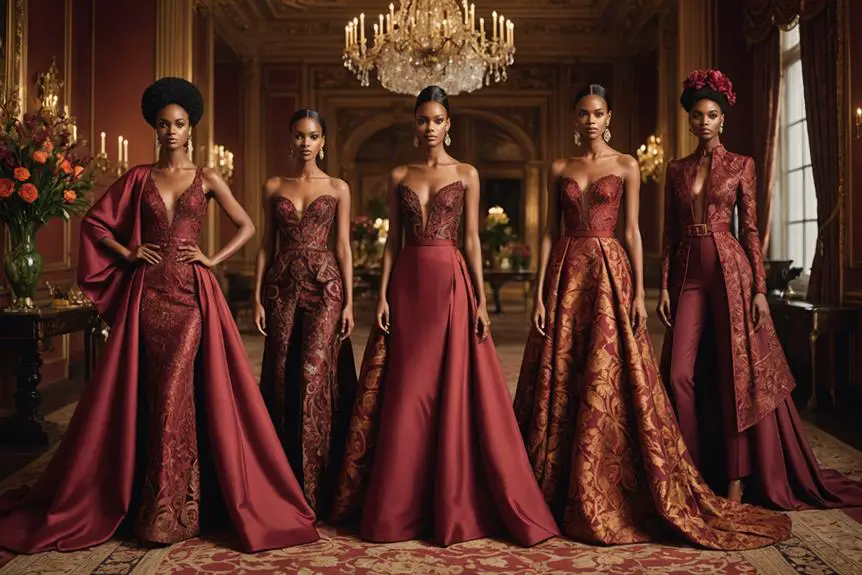When you think about "Mahogany," it's impossible to overlook the striking outfits that define the film's aesthetic. Each costume does more than just adorn Diana Ross; they tell a story of ambition and the quest for identity, mirroring the vibrant culture of the 1970s. You might find yourself wondering how these outfits not only shaped the character's journey but also influenced fashion trends beyond the screen. What's particularly fascinating is the intricate thought behind each design—something that reveals deeper layers of meaning in the film. Curious about what those layers might be?
Overview of Mahogany

"Mahogany" burst onto the scene in October 1975, featuring Diana Ross as Tracy Chambers, an ambitious fashion designer turned successful model. This film captures the essence of the 70s fashion world, showcasing a vibrant array of styles that not only define the era but also highlight Ross's unique vision. After being discovered as a model, Tracy undergoes a stunning transformation, rebranded as "Mahogany," and thrust into the glamorous fashion show circuits of Italy. The film's fashion elements resonate with the cultural impact of luxury brands like Ralph Lauren, which have similarly shaped perceptions of elegance and style vintage Ralph Lauren items often embodying a timeless quality that mirrors the film's aesthetic.
The film is particularly remarkable for its impressive wardrobe, boasting over 50 outfits designed by Diana Ross herself, which took an astounding eight months to create. These ensembles range from chic, everyday outfits that resonate with the working girl spirit to extravagant, bold pieces that dazzle on the runway. Each outfit reflects the era's trends, offering a feast for the eyes that captures audiences' attention, even as critiques emerge regarding the film's narrative depth and feminist values.
Despite its campy charm, "Mahogany" remains a cultural touchstone, celebrating the glitz and glamour of the fashion industry. The enthralling visuals and Ross's commanding performance guarantee that viewers remain engaged, even if the fashion sometimes eclipses the film's story. As you immerse yourself in the world of "Mahogany," you can't help but appreciate the impact of Diana Ross's character on the landscape of fashion and film, making this movie a pivotal moment in both industries.
Iconic Fashion Moments
The allure of "Mahogany" lies not just in its narrative but in the unforgettable fashion moments that define the film. Diana Ross, as the stunning Tracy Chambers, showcases a dazzling array of outfits that perfectly encapsulate the boldness of 1970s fashion, echoing the spirit of individuality found in the Harley Davidson community. One of the film's most iconic images is Ross in a hot pink gown designed by Bob Mackie, a striking embodiment of the "more is more" philosophy prevalent during that era.
The film features a mesmerizing four-minute fashion montage set against the backdrop of Rome, where you witness Ross's transformation into the glamorous model Mahogany. This montage is a feast for the eyes, highlighting her wearing avant-garde outfits that push the boundaries of conventional style. Ross designed 50 outfits for the film, effortlessly blending chic 70s staples with extravagant pieces that reflect the decade's audacity.
Among the standout fashion moments is a multi-colored rainbow dress that captured the admiration of many viewers, offering a pop of color in a sea of mixed reactions to other costume choices. The film's costume design also incorporates elements inspired by Kabuki aesthetics and Oriental motifs, further enhancing its unique visual style and contributing to a rich tapestry of cultural expression, much like the timeless style associated with Harley Davidson.
Ultimately, these iconic fashion moments not only define Ross's character but also contribute to a rich tapestry of cultural expression, making "Mahogany" a timeless celebration of style and individuality. The film remains a demonstration of the power of fashion in storytelling, leaving a lasting impression on audiences and fashion enthusiasts alike.
Costume Design Insights

Fashion in "Mahogany" goes beyond mere aesthetics; it serves as an essential storytelling tool that reveals character depth and cultural commentary. The film's costume designer, Diana Ross, crafted an impressive 50 outfits over eight months, showcasing her talent in fashion design and illustration. This dedication brought to life two distinct styles: everyday working girl outfits that embody the chic staples of the 70s and extravagant fashion pieces that reflect the era's flamboyance.
Working alongside wardrobe coordinator Susan Gertsman, Ross faced initial skepticism from director Berry Gordy regarding her role. However, her vision shone brightly, blending inspirations from Kabuki aesthetics and influences from an Oriental shop. This fusion resulted in a dazzling mix of elegance and outrageousness, particularly evident during the charity fashion shows depicted in the film.
Critics initially mocked the costumes, but over time, they gained acclaim, demonstrating the fashion industry's unpredictability and the evolving perception of trends. You can see how each outfit serves a purpose, whether it's to highlight the struggles of the working girl or to celebrate the glamor of high society. This dynamic wardrobe not only reflects the characters' journeys but also acts as a commentary on the era's societal expectations and cultural shifts. By examining these girl outfits, you gain insight into the film's broader narrative and the unique role fashion plays in storytelling. "Mahogany" truly showcases how costume design can elevate a film into a rich tapestry of cultural expression.
Themes of Ambition and Identity
In "Mahogany," ambition and identity intertwine as viewers witness Tracy Chambers' transformative journey. Portrayed by the iconic Diana Ross, Tracy begins as a department store secretary, dreaming of becoming a successful fashion designer. Her ascent to the heights of the modeling industry showcases her determination and the dreams of many young women aiming for recognition and success. As you follow her journey, it becomes clear that fashion isn't just about clothes; it's a powerful medium for self-expression and identity. The film's exploration of fashion also resonates with the historical evolution of iconic brands like Burberry, which have navigated societal expectations and cultural movements over time, highlighting the significance of vintage fashion identification.
Tracy's evolution from a modest background to an internationally recognized model highlights the complex relationship between personal aspirations and societal expectations. Throughout the film, you see how she navigates love and career, ultimately prioritizing relationships over her ambitions. This reflects the traditional roles often assigned to women, adding depth to her character and making her journey relatable.
The extravagant costumes designed for Tracy serve as a visual feast, illustrating her successes while also shedding light on the superficiality of the fashion world. Each outfit represents a stage in her identity formation, symbolizing both triumphs and the challenges she faces. Additionally, the film poignantly addresses the systemic barriers that young women in black neighborhoods encounter, making Tracy's story resonate on a broader scale.
"Mahogany" offers a compelling exploration of ambition and identity, inviting you to reflect on how dreams shape who we are, while also emphasizing the importance of choosing what truly matters in life.
Cultural Impact on Fashion

Reflecting on Tracy Chambers' journey in "Mahogany," it's clear that the cultural impact of the film on fashion is profound. The 1970s flamboyant and extravagant style showcased in the film not only defined an era but also transformed the portrayal of black women in the fashion industry. With Miss Ross herself designing 50 outfits, she blended everyday chic with over-the-top high fashion, sparking conversations around black femininity and ambition. The film's use of vibrant colors and unique textures also exemplified the rich fabric choices typical of vintage clothing, showcasing how popular vintage categories can reflect cultural narratives.
Initially, some critics dismissed the film's costumes, but as time passed, "Mahogany" gained acclaim for its bold fashion statements. This evolution highlighted how perceptions of 70s fashion have changed, emphasizing its lasting influence on contemporary trends. The film's iconic fashion moments elevated the status of black designers and models, pushing them into the mainstream narrative during a time when representation was sorely lacking.
For young black women, the film resonated deeply, showcasing fashion as a powerful expression of identity and aspiration. It encouraged viewers to embrace their unique styles and seek empowerment through self-expression. With every stunning outfit and striking scene, "Mahogany" became more than just a film; it became a cultural milestone that inspired generations. The celebration of black femininity and ambition through fashion continues to inspire today, reminding us of the importance of representation and the transformative power of style.
Frequently Asked Questions
What Are Mahogany Movies on Hallmark?
Mahogany movies on Hallmark focus on character development and cultural representation, showcasing heartfelt love stories that highlight family and community. They resonate with audiences seeking relatable narratives, celebrating African American culture and empowering diverse voices.
Was Mahogany a Good Movie?
You might find "Mahogany" a mixed experience. While some appreciate its lavish visuals and ambition, others critique its narrative and character depth. A Mahogany film review reveals both charm and flaws in the character analysis.




